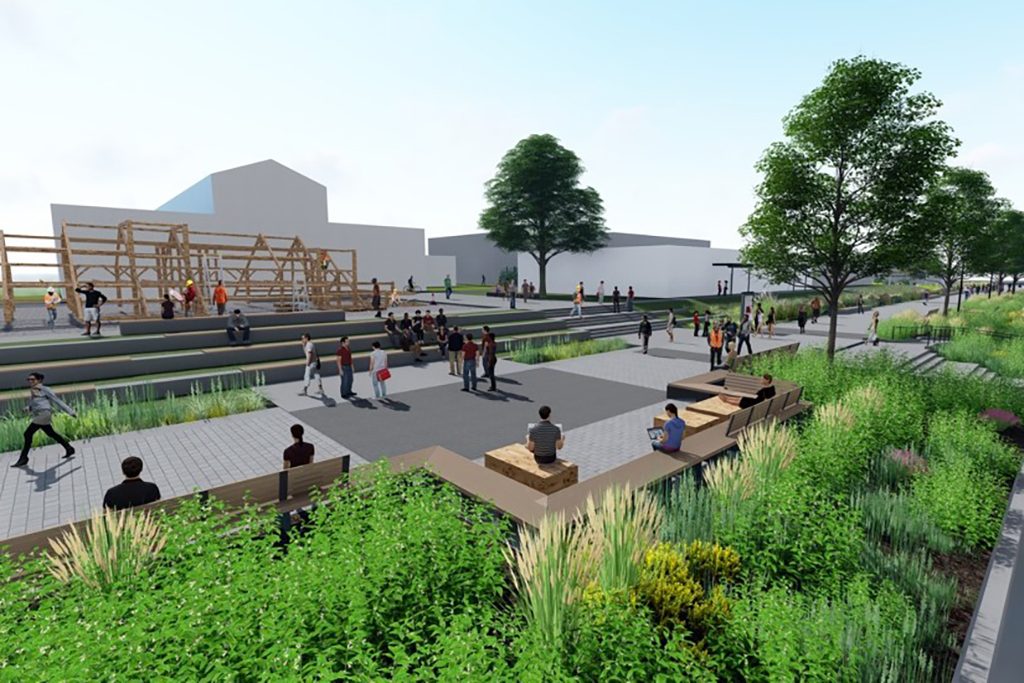The B.C. Institute of Technology (BCIT) is poised to expand over the next 20 years, adding as many as 10 new buildings at its Burnaby, B.C. campus which serves as the hub of what is B.C.’s largest skills training institution.
But, in order facilitate change, the north side infrastructure servicing the Burnaby campus master growth plan needed a complete overhaul as it stretched back to the early 1960s. The result of the major $46.9 million renewal project has earned the North Campus Infrastructure Project at the campus an Envision Gold Award for sustainable infrastructure.
BCIT is the first educational institution in Canada to have the sustainability of one of its infrastructure projects validated (through a rigorous, third-party process) against the Envision framework, according to a BCIT press release.
The sustainability features built into the system turned a street into a pedestrian way (English Walk), increased bicycle routes, and, integrated Canada’s first Smart Power Microgrid, now under designed and constructed by BC Hydro and BCIT, into the campus power system.
“It (Microgrid) is a feature that allows BCIT to use solar and wind (as forms of non-traditional energy) and do it through the system to accommodate growth over time,” said Quin MacKenzie, sustainable design lead for Stantec, which was involved in the project.
Microgrids can function independently and collaboratively, balancing power generation with demand and reducing the potential for blackouts in extreme weather events. It can integrate traditional natural gas and hydro with alternate sources such as biomass, solar and wind. Full integrations could provide BCIT with the ability to operate off-grid in the future, in the event of an emergency or other power failure.
“Additionally, we also looked at what some climate changes would bring to Metro Vancouver and what we could do to accommodate the project warmer summers and more precipitation in fall,” she said. More than 60 per cent of the project’s surface has a high solar reflectance index value which will keep surfaces cool in the presence of solar radiation. The project’s landscaping will also serve to mitigate localized “heat islands” and contribute to a cooler campus microclimate during the expected increase in dry spells and increased ambient air temperatures
But, before these much of the sustainability features could be incorporated, the old infrastructure had to be ripped up and new infrastructure placed.
“The infrastructure was at – or past – the end of life and if we were going to have a lot of new buildings, they would have had to plug into that infrastructure,” said Daniel Clement, director of facilities services who handled construction oversight for BCIT and served as part of the consultation team. The infrastructure upgrading included electrical, storm drains, water and sewer lines and challenges were constant.
Key team members, aside from Clement, were PCL Constructors Westcoast, Western Pacific Enterprises, R.F. Binnie & Associates, PFS Studio, and Stantec.
Work had started with a comprehensive investigation of the underground utilities that had been patched and cobbled together for decades. They were in critical risk of failure, which would have resulted in disruption of classes and closure of buildings.
In a growing campus, power was an issue. A new power receiving substation was needed to replace the 60-year-old Canada Way receiving substation which powers about 50 per cent of the campus, including all of the campus trades-based educational programs. The project also includes replacing 11 substations and all related infrastructure and establishing a new BC Hydro connection at the corner of Carey Ave and Canada Way.
The new electrical backbone infrastructure on the north side of campus now has three major electrical services: high voltage (HV -12.5/25kV); low voltage (LV – below 750V); and a telecommunications, control, and safety service. The new electrical infrastructure is currently 12.5kV, but with a slight modification can carry the larger capacity of 25kV as needed for a growing campus.
The degraded underground utilities, though, posed some dangers to the individuals pulled in to work on them. It became a best practice that no crew member entered an energized manhole. “We were concern because of old insulation or water leaks,” Clement said. The construction crew – with a major component of former BCIT trades graduates – shut off power to these access areas before venturing down. There were occasions when the entire campus, or portions of it, had to be placed on temporary generators to ensure crew safety.
Not entering energized holes was a lesson taken away from the previous infrastructure upgrade on campus which was also completed in 2015 by PCL. PCL’s project manager Chad McPhee said this current project is “three times the size” of the earlier upgrade, but did provide valuable lessons in organizing work and safety practices for the current project.
McPhee said another looming concern was the aging shut-off valves in the underground water system. “We were not sure they would operate,” he said, as crews did not want to be in a hole and have shut-off valve fail. As a result, said McPhee, the crews first replaced all the shut-offs to ensure their integrity and then began working on the water line replacement. “We knew they would shut off, we didn’t have to guess,” he said. Hexcel Construction was used as the civil contractor for the project.
Clement said the success of the large project was helped through the integrated design approach with the construction and design teams working collaboratively to determine how best to renew the infrastructure and meet future campus demands. Companies were retained on a consultant and then the contracts were put out to public bidding. In most cases, the consulting companies were the successful bidder. As the project was a major one, it was a training site for many apprentices. Clement estimates that 4,800 hours of apprenticeships were logged on this project.
Clement considered the greatest challenge that of simply co-ordinating the work with the busy campus activities. Infrastructure replacement is not something visibly tangible like seeing a new building take shape, he said, yet it delivers a lot of the same frustrations such as noise, disruptions, and moving construction equipment on site.
PCL began as a construction manager early in the pre-construction phase and then converted to the general contractor. McPhee agreed that coordination and collaboration were pivotal to the project’s success.
“The biggest challenge was keeping the campus open and operational,” he said as 20,000-30,000 students traversed the grounds daily. “It involved a lot of preplanning and close communications with the various (BCIT) departments regarding where we might be and how long,” he said. “We also had to flexible to their needs.” Such as holding back on the noise if a class or exam was in session or rescheduling the work until later in the day.











Recent Comments
comments for this post are closed